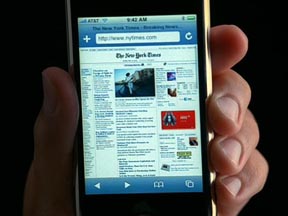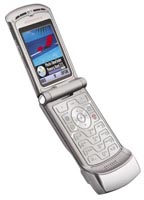 TechNewsWorld posted today about the “incredibly weak mobile Web experience” and asked “why mobile Web browsers are still so lame.” My answer: Today’s cell phones, with a few exceptions, are not information devices and should not be compared with the desktop experience.
TechNewsWorld posted today about the “incredibly weak mobile Web experience” and asked “why mobile Web browsers are still so lame.” My answer: Today’s cell phones, with a few exceptions, are not information devices and should not be compared with the desktop experience.
I’d like to get away from the thinking that most of the cell phones today are information devices. They’re not. They’re phones that are Internet-enabled, so you can surf the Web.
I’d also like to get away from the thinking that the mobile Web experience should be like surfing the Web on our desktops or laptops. It’s not the same experience. It never will be. One is large, with at least a 12-inch display, and the other is tiny, with a match-book-sized screen.
What’s needed to improve the mobile Web experience, first and foremost, is a new cell phone that’s designed and development to meet the information — not just the phone — needs of an on-the-go society living in a broadband world. With the appropriate hardware, only then can we improve mobile browsing.
Our Evolving Lives
 We’re not living in the early cell phone world anymore. It’s Web 2.0 baby, and we’re interacting with more information than ever before. Phone calls, voice messages, and emails are old hat: Now we’ve got SMS, camera phones, video phones, Web-surfing phones, and all these (information rich) places to visit on a daily basis — MySpace, Facebook, YouTube, Flickr, Twitter, Google Maps, and Websites that give us sports scores, stocks, and movie listings.
We’re not living in the early cell phone world anymore. It’s Web 2.0 baby, and we’re interacting with more information than ever before. Phone calls, voice messages, and emails are old hat: Now we’ve got SMS, camera phones, video phones, Web-surfing phones, and all these (information rich) places to visit on a daily basis — MySpace, Facebook, YouTube, Flickr, Twitter, Google Maps, and Websites that give us sports scores, stocks, and movie listings.
Few devices today can handle this much information, no matter how well designed mobile browsers such as Pocket IE, Opera, Nokia, and BlackBerry are. What makes Apple’s iPhone work is that the hardware and browsing software (Safari) were developed in tandem; all other browsers face substantial limits and obstacles.
We like our information too much, and we want our phones and mobile browsers to bring it to us, anytime, anywhere. And according to some reports, there are more information-rich devices being sold now than ever before. TechNewsWorld notes that 115 million “smartphones” will be shipped this year, with 410 million expected to be sold in 2012.
What Needs to Change?
What needs to change so the mobile Web browsing experience is finally a pleasant one? Hardware. Interface design. Ease of connecting to the Web from a mobile device. And our expectations.
Size
 Since the cell phone was first invented, the goal has been to make it as small and comfortable to carry as possible. The results are tiny displays and a cramped keypad, none of which are conducive to an enjoyable mobile browsing experience. Your phone, though, is razor-thin and available in cool colors.
Since the cell phone was first invented, the goal has been to make it as small and comfortable to carry as possible. The results are tiny displays and a cramped keypad, none of which are conducive to an enjoyable mobile browsing experience. Your phone, though, is razor-thin and available in cool colors.
Face it: For the mobile browsing experience to improve, the phone will need to get bigger, not smaller. The iPhone is a good start, balancing a larger display with the device’s overall size. It is still “pocketable”.
Interface
 To reach the size of the iPhone, Apple made some bold interface decisions — ones that are affecting user interface designers at Motorola, Samsung, and maybe even Google (who’s rumored to be releasing the Gphone in early 2008). Apple decided to ditch the keyboard, the ones used by BlackBerry and the Palm Treo, among others, because it eats up device space and the keys are often tiny and hard to use.
To reach the size of the iPhone, Apple made some bold interface decisions — ones that are affecting user interface designers at Motorola, Samsung, and maybe even Google (who’s rumored to be releasing the Gphone in early 2008). Apple decided to ditch the keyboard, the ones used by BlackBerry and the Palm Treo, among others, because it eats up device space and the keys are often tiny and hard to use.
Apple went with a touch-sensitive display and software-driven virtual keyboard, allowing for a larger screen and a reasonably-sized device. Some people hate the virtual keyboard; others (myself included) love it.
What’s important here is that a manufacturer pushed the limits, invented something new, and its impact on the mobile Web experience is already being felt. It’s much nicer to surf the Internet on the iPhone, even with a limited Safari browser, than it is on any other device. In fact, today’s phone keypads were meant for punching in numbers, making calls, accepting calls, and accessing features and settings, not surfing the Web or navigating Google Maps.
Ease of Connection
 The other day I watched 17 students trying to get Windows Mobile smartphones connected to the school’s secure Wi-Fi. After more than an hour, a few actually connected to the Internet. Most everybody left the campus hopping to connect their phones to home wireless networks, where the security isn’t so air-tight. Two days later, the students are still complaining about logging in difficulties, dropped connections, and general frustrations.
The other day I watched 17 students trying to get Windows Mobile smartphones connected to the school’s secure Wi-Fi. After more than an hour, a few actually connected to the Internet. Most everybody left the campus hopping to connect their phones to home wireless networks, where the security isn’t so air-tight. Two days later, the students are still complaining about logging in difficulties, dropped connections, and general frustrations.
This behavior is completely unacceptable and must disappear for the mobile Web browsing experience to improve and move beyond early adopters and “techies.” I like the behavior of the iPhone: I walk into a location, a notice pops up on the display asking me if I want to join a network, and I tap the name. If it’s secure, I provide a password and the device remembers the network, so when I return I am automatically connected.
Last But Not Least, Technology
Even with improved hardware, the best interface, and the easiest connections, the mobile Web browsing experience can go only so far. The last piece of this puzzle belongs to the mobile carriers, who are building the networks. At least for the foreseeable future these networks are going to be 2.5G or 3G, which are serviceable for basic Web needs like checking email, writing messages, sending SMS, or conducting simple web surfing.
But for the mobile Web browsing experience to approach anything like wired and wireless connections at home or in the office, the carriers will have to deliver the so-called 4G technologies such as WiMax, LTE, and UMB. Thank goodness Wi-Fi is now available on some phones.
Conclusion
Think of this time as the mid ‘90s, when personal computers were coming into vogue, when Netscape released the first commercial Web browser, and when Internet connections started getting a little faster.
History is repeating itself. Only now it’s mobile.

As a relatively new mobile phone user, my expectations were pretty high regarding what was possible on a phone. I can see now we have a long way to go. I am still having trouble getting pictures from the phone onto the web.
Good article.
This is what makes the iphone revolutionary.
I agree with you about the hardware, but the root of the matter also sits on the platform of the device. While testing the Samsung i600GSMH, which is running a windows mobile version, randomly maintains network (Wi-Fi) connectivity.
The network connection was unstable as I moved around the city bouncing from secure to open Wi-Fi networks. At least it was consistent at dropping connections. I would like to see a device that can find a network, list the availability, and stick to the selection and bada-bing you are cruising without being dropped.
The calendar is nice though, and it has some pretty pictures to set as a background. Did I mention the cool ring tone I set?
while being one of those 17 students who pulled out their hair trying to get the wifi to work, i completely agree.
plus, the i600 has trouble with cell service. what good is a wifi, media enabled, cool phone if it’s not a phone at all? a media device needs to get the basics down pat before moving on to more “complicated” things
Interesting article.
Aren’t the words we’re using also antiquated? Cell phone aren’t really just phones any more; they’re devices (yes, portable too) that allow us to connect with others, be more productive and also have fun too. We need a new word(s) to describe what we currently call phones.